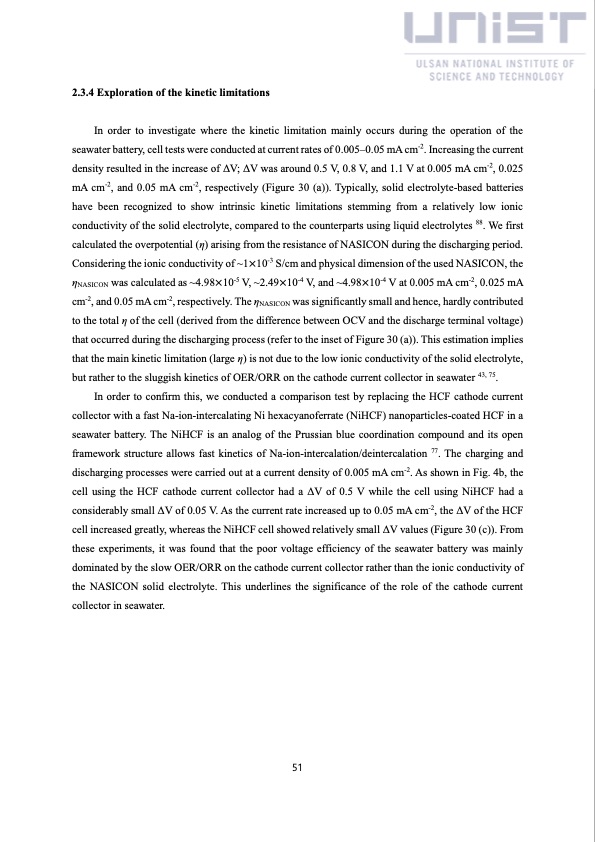
PDF Publication Title:
Text from PDF Page: 056
2.3.4 Exploration of the kinetic limitations In order to investigate where the kinetic limitation mainly occurs during the operation of the seawater battery, cell tests were conducted at current rates of 0.005–0.05 mA cm-2. Increasing the current density resulted in the increase of ΔV; ΔV was around 0.5 V, 0.8 V, and 1.1 V at 0.005 mA cm-2, 0.025 mA cm-2, and 0.05 mA cm-2, respectively (Figure 30 (a)). Typically, solid electrolyte-based batteries have been recognized to show intrinsic kinetic limitations stemming from a relatively low ionic conductivity of the solid electrolyte, compared to the counterparts using liquid electrolytes 88. We first calculated the overpotential (η) arising from the resistance of NASICON during the discharging period. Considering the ionic conductivity of ~1×10-3 S/cm and physical dimension of the used NASICON, the ηNASICON was calculated as ~4.98×10-5 V, ~2.49×10-4 V, and ~4.98×10-4 V at 0.005 mA cm-2, 0.025 mA cm-2, and 0.05 mA cm-2, respectively. The ηNASICON was significantly small and hence, hardly contributed to the total η of the cell (derived from the difference between OCV and the discharge terminal voltage) that occurred during the discharging process (refer to the inset of Figure 30 (a)). This estimation implies that the main kinetic limitation (large η) is not due to the low ionic conductivity of the solid electrolyte, but rather to the sluggish kinetics of OER/ORR on the cathode current collector in seawater 43, 75. In order to confirm this, we conducted a comparison test by replacing the HCF cathode current collector with a fast Na-ion-intercalating Ni hexacyanoferrate (NiHCF) nanoparticles-coated HCF in a seawater battery. The NiHCF is an analog of the Prussian blue coordination compound and its open framework structure allows fast kinetics of Na-ion-intercalation/deintercalation 77. The charging and discharging processes were carried out at a current density of 0.005 mA cm-2. As shown in Fig. 4b, the cell using the HCF cathode current collector had a ΔV of 0.5 V while the cell using NiHCF had a considerably small ΔV of 0.05 V. As the current rate increased up to 0.05 mA cm-2, the ΔV of the HCF cell increased greatly, whereas the NiHCF cell showed relatively small ΔV values (Figure 30 (c)). From these experiments, it was found that the poor voltage efficiency of the seawater battery was mainly dominated by the slow OER/ORR on the cathode current collector rather than the ionic conductivity of the NASICON solid electrolyte. This underlines the significance of the role of the cathode current collector in seawater. 51PDF Image | China solar seawater battery

PDF Search Title:
China solar seawater batteryOriginal File Name Searched:
solar-seawater.pdfDIY PDF Search: Google It | Yahoo | Bing
Product and Development Focus for Salgenx
Redox Flow Battery Technology: With the advent of the new USA tax credits for producing and selling batteries ($35/kW) we are focussing on a simple flow battery using shipping containers as the modular electrolyte storage units with tax credits up to $140,000 per system. Our main focus is on the salt battery. This battery can be used for both thermal and electrical storage applications. We call it the Cogeneration Battery or Cogen Battery. One project is converting salt (brine) based water conditioners to simultaneously produce power. In addition, there are many opportunities to extract Lithium from brine (salt lakes, groundwater, and producer water).Salt water or brine are huge sources for lithium. Most of the worlds lithium is acquired from a brine source. It's even in seawater in a low concentration. Brine is also a byproduct of huge powerplants, which can now use that as an electrolyte and a huge flow battery (which allows storage at the source).We welcome any business and equipment inquiries, as well as licensing our flow battery manufacturing.| CONTACT TEL: 608-238-6001 Email: greg@salgenx.com | RSS | AMP |